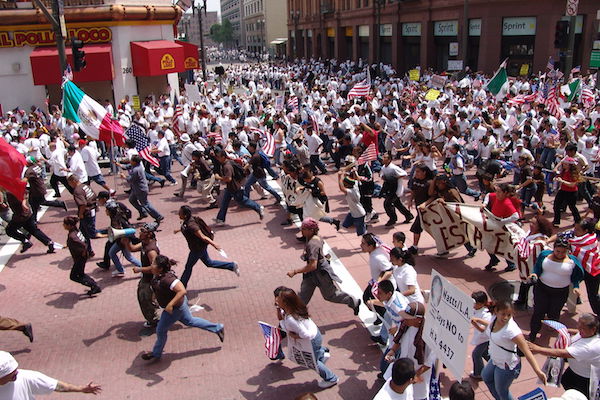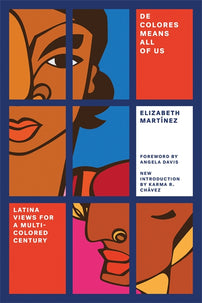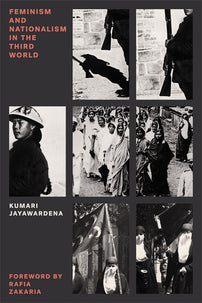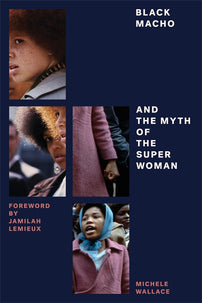The Coalition Ethic: On De Colores Means All of Us
Betita Martínez’s work comprises one of the most important living histories of progressive activism in the contemporary era.

Our Feminist Classics series brings together foundational left feminist texts at the intersection of class and race, addressing debates that continue into the present day. Included in the latest set is Elizabeth Martínez's landmark work of Latinx feminism, De Colores Means All of Us: Latina Views for a Multi-Colored Century — Karma R. Chávez's new introduction to which is reproduced below.
All the books in our Feminist Classics series are 40% off until August 20th at 23.59 (Pacific Time). Click here to activate your discount.
In the nearly twenty years that have passed between the dawn of 2017 and the original writing and publication of De Colores Means All of Us, movements and organizing in the settler colonial state most call the United States of America have been vibrant — hope, devastation, rage, and righteousness have characterized these first two decades of the twenty-first century. Veterans have stayed the course, new voices have emerged, and a spirit of justice continues to carry the energy of so many of us who, in myriad ways, fight the structures, institutions, and otherwise oppressive forces that face us. In these ways, the early twenty- first century is no different than the decades and centuries that preceded it, even as the particularities of this historical moment present new challenges.
It is worth mentioning just some of these moments in recent movement history — moments in which communities of color have not only played roles, but have also often been the primary physical laborers, intellectual creators, and spiritual forces. The twentieth century faded with the so-called Battle of Seattle, where protestors from around the globe went to Seattle to challenge the World Trade Organization, corporate colonialism, and free trade policies. Mere months after the US Supreme Court gave George W. Bush the 2000 presidential election against Al Gore, the attacks of September 11, 2001 animated the Bush–Cheney war machine. The so-called War on Terror catalyzed old and new anti-war protestors, who continue to challenge US actions, first in Afghanistan, then in Iraq, then under Obama and now Trump, in other parts of the region.
While anti-war efforts waged on, in late 2005, Wisconsin Republican congressman Jim Sensenbrenner proposed HR 4437, which passed the House but failed in the Senate and would have required, among other provisions, the construction of 700 miles of border fence, aggressive deportation practices, and criminalization of citizens and legal residents who house or otherwise harbor undocumented folks. Largely Latinx, Asian, and immigrant groups took to the streets throughout the spring of 2006 with some of the largest protests since the civil rights era to challenge anti-immigrant actions and laws. Less than two years later, when then-candidate Barack Obama announced his support for the DREAM Act, undocumented youth who had cut their teeth on activism in the 2006 protests catalyzed a national movement to advocate for the DREAM Act and comprehensive immigration reform. Although these actions fell short of their primary objectives, they did prompt Obama to pass an executive order in 2012 called the Deferred Action for Childhood Arrivals, which gave select undocumented youth a slight reprieve from being targeted for deportation and granted access to a legal work permit. Following actions by people in the Middle East and North Africa against authoritarianism, joblessness, and corruption, among other factors, that led to what some call the Arab Spring of late 2010, in 2011 tens of thousands of protestors in Wisconsin took to the streets for months to challenge laws passed by the newly elected Republican governor Scott Walker and the new Republican state legislature that stripped public unions of collective bargaining rights and gutted the historic University of Wisconsin system. Later that year, protestors set up camp in Zuccotti Park in New York City’s financial district to challenge wealth inequality and corruption on Wall Street. Occupy and in some cases (Un)Occupy camps were set up around the country in strategic locations to challenge the rule of the 1% and to provide temporary shelter and support for local homeless people.
Although police and vigilante violence against black, brown, indigenous, and immigrant communities is as old as the republic itself, the February 2012 killing of eighteen-year-old black youth Trayvon Martin by neighborhood vigilante George Zimmerman in Florida catalyzed a national movement that is still in full swing. Deemed by Opal Tometi, Alicia Garza, and Patrisse Cullors, Black Lives Matter, in its national and local iterations, this movement — led largely by black queers, trans folks, and/or women — challenges state violence against black communities and seeks community-based responses to oppression. Following the 2014 police killing of eighteen-year-old black youth Michael Brown in Ferguson, Missouri, the movement was further stoked as the Ferguson Rebellion became a meeting place for national groups to support one another and be trained. These years of efforts have resulted in a Movement for Black Lives vision statement and the development of black youth leadership around the United States. Late 2016 was characterized not just by the brutal presidential election, but by the stand off at the lands of the Standing Rock Sioux Tribe in North Dakota, as indigenous leaders and thousands of allies set up camp to protest the building of the Dakota Access Pipeline, which would have run under sacred sites and come dangerously close to the tribe’s water supply. While each of these uprisings has morphed in different ways, the principles they each represent continue beyond the immediate crisis points that made, or should have made, the front pages of national newspapers.
Many other struggles and uprisings could and probably should be mentioned here, including battles over public higher education and tenure, the ongoing pursuit of justice for Palestinians and the burgeoning Boycott, Divestment and Sanctions movement, movements for reproductive justice and universal health care, ongoing struggles against environmental degradation and racism, and more. I’d be remiss not to mention that I am writing this introduction on the Martin Luther King Jr. holiday, a week before the inauguration of Donald Trump as president of the United States. Weeks of protest and organizing against Trump’s wildly draconian proposed policies and cabinet appointments, not to say anything about his fascist tendencies, are planned and are likely to continue. Trump’s election, and the fact that more than half of white women and nearly one-third of Latinxs supported him, left many stunned and, I hope, many more ready for a new brand of political, social, cultural, and economic warfare. Now above age ninety, Betita Martínez must have a lot to say about all this, but she’s not doing the public speaking and training she once did. Luckily for all of us, we have De Colores Means All of Us, which, as Angela Y. Davis wrote in the foreword to the first edition, is an indispensable guidebook of principles with which we are well armed for the coming millennium and for all the battles it already has begun to present.
I concur wholeheartedly with Davis that Martínez’s work comprises one of the most important living histories of progressive activism in the contemporary era. The lesson that remains most prominent and, I believe, significant is that of the necessity of coalition building across numerous axes of difference. As Martínez reminds us, affirming our distinct identities as communities of color is vitally important, but perhaps more so is the commitment to challenging the deep structures — namely capitalism, white supremacy, and colonialism — as the forces that shape and constitute our collective existence. As people of color, getting mired in personality differences, the weight of our own in-community struggles, or adopting unreflexive forms of nationalism will not serve our revolutionary aims. As Martínez puts it, we must recognize our interdependence, and the need to build on it, as a fundamental, life-saving strategy.
Working together requires our individual and communal labor — overcoming mutual prejudice, acknowledging our weaknesses in relation to power, and approaching one another with respect and humility. Martínez’s own work with SNCC from 1961 to 1968 provides one helpful model for how to think about such coalitional orientations. In her essay in Hands on the Freedom Plow: Personal Accounts by Women in SNCC, she explains her thinking about why it made sense for her as a Mexican American to work on black liberation: "I had wanted to spend my life tearing down the prison called white supremacy and there was no better place to do it than alongside African Americans." This same belief led her to realize that she wasn’t abandoning that struggle when she left SNCC to work on behalf Chicanx people in New Mexico. She notes that a voice in her head revealed to her, the two prisons are really one. And the fight is really one. This simple equation doesn’t capture the complexity or difficulty of seeing our struggles as shared, and to err too far in the direction of similarity for the sake of building coalitions can be dangerous. As the black feminist Bernice Johnson Reagon famously put it in her essay, "Coalition Politics: Turning the Century," coalition is not a home, and in fact, "coalition can kill people." Yet, when we approach the work from a place of deeply principled ideological commitments, the shared prison metaphor can be quite apt. As Martínez shows in her close and careful discussion of the Fuerza Unida strike against Levi’s, the United Farm Workers’ grape boycotts, the SouthWest Organizing Project’s challenges to environmental racism, and the work of the Southwest Network for Environmental and Economic Justice to combat racism and build a just organization, it becomes strikingly clear that recognizing our shared prisons doesn’t negate the good work of wrestling with our differences but it can help to achieve righteous, collective ends.
Another key lesson from Martínez regards the necessity for progressives and revolutionaries to do intergenerational work, and to do it well. Although I’m not yet forty years old, I often find myself in similar conversations as Martínez when someone much younger says a version of "but that was back in the early 1990s." While Martínez laments the focus of many young people that doesn’t include a serious consideration of the past, she cautions about the risks of movement veterans analyzing the work of revolutionary youth. She also shows that in those fated old days of the 1990s the youth had a lot of things figured out that her generation did not, like the significance of strong and legitimate female leadership and a reckoning with issues like homophobia. Throughout this book, Martínez reminds readers again and again of why we should balance the wisdom of experience with the fire of youth and honor both perspectives. So many great leaders have boldly embodied this ethic, from the recently departed such as Yuri Kochiyama, Grace Lee Boggs, and Cedric Robinson, to those who carry on like Jamala Rogers, Miss Major Griffin-Gracy, and Betita Martínez herself.
Finally, so much of Martínez’s work calls us to reconsider the black–white schema for US racial politics. As Martínez insists, a bipolar model of racism has never been really accurate for the United States. This claim is no doubt true, but there is a great risk in reducing the significance of the black–white paradigm or locating Latinx people outside of it. As of late, the identity of "Afro-Latinx" has become one of significance. In early 2016, Gustavo López and Ana Gonzalez-Barrera of the Pew Research Center issued a report, "Afro-Latino: A Deeply Rooted Identity Among US Hispanics," which claimed that nearly one quarter of Latinxs in the United States identify as Afro-Latinx — a substantial part of the US Latinx population. Questions of Afro-Latinidad have emerged as significant in many of the racial justice movements of the day, perhaps most significantly in the immigration justice movement. As the Black Lives Matter movement continues to reveal, anti-blackness is a unique manifestation of racism. The anti-blackness of slavery and the anti-indigeneity of settler colonialism are the foundational forms of group-based oppression in the United States. Non-black people of color both benefit from and perpetuate anti-blackness. It seems to me that one way to address the dilemma that Martínez poses is to think about the needs of the Latinx community by beginning from the lens of Afro-Latinx people. Such an approach may help us to address anti-blackness within and outside the Latinx community, and beyond that, to understand even more fully the ways that while discrete identity categories can be important, they often don’t reflect the reality of our experiences and may not be the most helpful in seeking revolutionary change.
As she has for decades, Betita Martínez both opens and answers questions, she lives the coalition ethic she espouses, and she reminds us eternally, that achieving justice requires all of us.
[book-strip index="1" style="display"]





